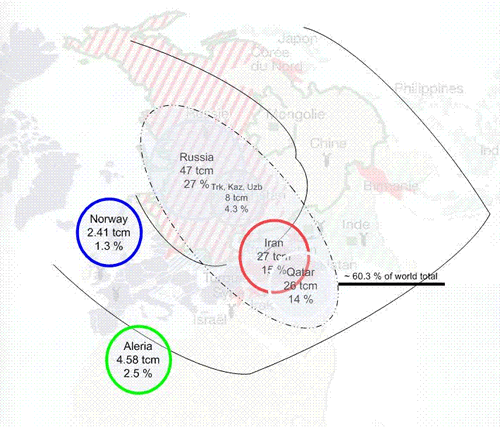
Introducing Timothy Boon von Ochssée
Timothy Boon von Ochssée is a researcher at the Clingendael International Energy Programme (CIEP) and works on a PhD about the global gas market.
Article
This article is basically an account of the changing relationship between Russia on the one hand and the US on the other in the context of a changing energy security environment.
Since the end of the Cold War, and as the twenty-first century continues to unfold, international relations amongst the great powers have undergone fundamental changes. In one important respect, access to energy – and in particular fossil fuels – is reshaping the post-Cold War environment today more profoundly then could have been foreseen during the 1990s. High oil prices, underpinning geopolitical tensions, increased demand for energy at large and a host of other factors testify to the prominent position energy has been given on the international agenda. Energy security was on the top of the agenda during the G8 summit, held in St. Petersburg in July 2006. Indeed, many experts predict that fossil fuels and their transport will be the single dominant factor in international politics in the coming years and decades.[1]
With fossil fuels set to dominate energy consumption for many years to come, and with demand projected to rise even further in combination with a greater import dependency on the part of importing countries such as the US and Europe (holding for China and India as well), this trend is likely strengthen inexorably. In addition, large oil and gas consuming regions will become increasingly dependent on fewer and fewer countries. This fundamentally shifts the balance of power to those countries upon whom continued energy flows depend. Several dimensions coalesce to bring an increasingly complex kaleidoscope of relationships between consumer and producer countries. In the context of this article, there are three dimensions: the first one pertaining to a changing gas industry, the second to a changing relationship between Russia and the US (and a changing Europe) and the third to a complex Russian energy strategy.
Natural gas
Natural gas, found in abundance in only a handful of countries (Russia, Iran and Qatar together possess over half the world’s proven gas reserves, see Figure 1 below), is increasingly the fuel of choice for a number of end-uses. Natural gas has several advantageous: for example, it is cleaner then oil and coal in terms of CO2 output and gas-to-power stations take less time to build than nuclear power stations. In a post-Kyoto world, gas is a relatively important source of energy not only for power generation but also for household activities and large industries such as those found in the petrochemical sector. A development that has and is transforming the landscape of the natural gas industry is the advent of Liquefied Natural Gas (LNG). The share of natural gas in the primary energy mix is rising faster than that of oil and coal [2] and the gas industry is simultaneously undergoing immense changes as new technologies, demand and supply patterns entice new market forces.
Figure 1: The concentration of the world’s largest known gas reserves, 2007:
Source: Figures are from the BP Statistical Review of World Energy 2007. Note: tcm: trillion cubic meters.
This mode of transport allows gas exporting countries to ship their gas over long distances and releases them from the traditional dependence issues associated with pipelines. Pipelines are expensive and once built indefinitely tie producers and consumers while LNG allows both exporting and importing countries to escape this form of captivity. This understandably has both commercial as well as geopolitical consequences. Be that is it may, Europe is increasingly dependent on rising pipeline imports from Russia and Norway as well as Algeria while LNG imports form only a modest share of Europe’s gas imports (10 percent)[3], concentrated mainly in Spain, France and Italy. The US too is bound to become a major LNG importer over the coming decades, according to the IEA.[4]
Russia in transition
Since the collapse of the Soviet Union, Russia has undergone momentous changes and has, as a great power, experienced internal economic and political upheaval under Yeltsin during the 1990s and has had to cope with a loss of influence in the post-Soviet space. The CIS, established amongst the leaders of the former Soviet states, replaced the Soviet Union, paving the way for entirely new relationships between Russia, the US and these newly independent states. During Yeltsin’s administration, the hope was in Europe and the US that Russia would develop in ways favoring Western interests. The expectation during the first half of the 1990s was that Russia would continue on its path towards ‘Westernization’ and that ultimately it would join the market-oriented system that has so shaped the development of Western Europe and the US[5]. In the midst of NATO and EU expansion as well as the changing dynamics of international relations mentioned above, Russia under Putin is attempting to rediscover its former status as a great power equal in status to the US and now also China. At the same time, Putin is pursuing a second goal: the integration of Russia into the global economy.[6]
Buoyed economically by high oil and gas prices, Russia is experiencing a new ‘state capitalist’ transformation based on the centralization of political and economic power in the Kremlin through state control of key strategic industries. Moscow believes the rising geopolitical and economic importance of oil and gas can reverse Russia’s old dependency on the West.[7] This is part of Russia’s reintegration process, not only domestically but also in the post-Soviet space. Putin sees the restoration of Russia’s international prestige as a priority. It would seem that, as an actor in international relations, Russia wishes to reacquire an important status in international affairs. In other words, its self-image could arguably be one of a great power returning to the global arena, with a desire to leave behind an economically and politically painful past. In that regard, it sees countries such as the Ukraine, Belarus and other CIS countries as part of its traditional sphere of influence.[8]
EU – NATO expansion
Meanwhile, the US appears to aim at maintaining its status as the sole superpower and as a lone global hegemony. For the US, maintaining and expanding its spheres of influence through a number of channels such as NATO and the EU is important to achieve this end. Consider the fervent support of the US for NATO expansion into the post-Soviet space (Georgia, Azerbaijan, etc.) as well as its continued ability to compel various NATO members to engage in US-led military operations. In the new and still-evolving post-Cold War environment Europe as a geographic area can be seen as a geopolitical battlefield between on the one hand the US and on Russia on the other. As the Soviet Union collapsed, many countries in Eastern Europe were quick to join NATO in an initial stage of breaking from their past as Soviet satellites, from a security perspective, while many of these joined the EU in a second, follow-up stage.
Under Yeltsin, NATO expansion was not seen as a major issue, however, under Putin, especially over the last two years, NATO expansion is increasingly seen as a renewed containment effort. Indeed, containing Russia has been the cornerstone of US foreign policy from the first years of the Cold War onwards, starting with President Truman’s term. There are clear indications that US foreign policy is still aimed at containing Russia, containment is still the paradigm in US foreign policy thinking. David Kramer, deputy assistant secretary of state for European and Eurasian affairs claimed in May 2007 that US policy toward Russia is mainly “cooperate wherever we can, push back whenever we have to.”[9]
Indeed, Russia’s growing energy clout, and its expanding influence in Europe through major energy projects such as the Nordtsream pipeline (which is to start exporting Russian gas to Germany from 2010 – 2011 onwards) and more recently the Southstream pipeline agreement between Russia and Italy is observed with increased irritation in US policy circles. Vice President Cheney’s comments about Russian policy at an international pro-democracy conference Vilnius, Latvia during May 2006 and statements made by Senator Lugar on NATO’s involvement in energy security at large at a NATO conference in Riga, Latvia in November 2006 (especially with regards to new NATO members) are manifestations that the US is keen to exploit changing CIS relationships to depict Russia’s energy ambitions as predatory. Then again, this is nothing new; when the Orenburg pipeline was laid from the Soviet Union to East and West Germany in the early 1980s the Reagan administration was quick to try to hamper its further development as a Soviet export channel for its natural gas. The fear amongst US strategists was that European dependence on Russian gas would provide Russia with additional leverage in its dealings with the US as far as Europe was concerned.
New US plans for missile shield
Having said the above, it is clear from the missile defense and Kosovo issues that Russia and the US have further high level disagreements, not to mention Iran’s nuclear program. The ‘missile defense’ system the US wishes to deploy in Poland and the Czech Republic is controversial indeed. Besides the question whether the system is at all technically feasible and whether Iran is capable of forming the perceived threat, the missile defense system is actually further evidence of US plans to consolidate its military presence in the post-Soviet space, at least the part now absorbed by the EU and NATO. Then, it is of course possible to use the system as a tool to control Russian air space west of the Urals, at least in theory.
It would seem that, in response to US plans to deploy the system, and to what it sees as US expansionism through NATO and the EU, Russia is withdrawing from the Conventional Forces Europe Treaty, which limits the number of conventional troop deployment in Europe. Russia will take “military measures” to counter the US plan to install the system, Deputy Foreign Minister Alexander Losyukov said. “Expansion of that kind into the area which is absolutely right next to our borders is increasing the military potential in that area,” Losyukov said in an interview at the Foreign Ministry in Moscow.[10] “Russia cannot but react to that increase,” Putin said, making clear his concern about US plans to build the missile defense system and the expansion of NATO as being possible challenges to Russia.[11]
Conclusion
As an institution and as a group of member states with widely diverging interests and foreign policies, the EU lacks a single foreign and energy policy and it cannot be seen as a single bloc. It is therefore logical that actors such as the US and Russia are likely to compete for influence by differing means in a region both see as their sphere of influence. Germany’s increasing dependence on Russian gas bears witness to the fact that Russia’s influence in terms of gas exports is not – or no longer, and actually never really has been – restricted only to CIS countries. Ever since the late 1960s, East-West gas trade has been an issue of ‘leverage’ for the US. The EU-Russia energy relationship underlines the key questions of international energy security, particularly as far as gas is concerned as well as the political dimensions: the tension between producers, consumers and transit states.[12]
Footnotes
[1] A. Rahr, ‘The New OPEC,’ Internationale Politiek, Spring 2006, p. 69.
[2] IEA, World Energy Outlook 2006, p. 67.
[3] IEA, World Energy Outlook 2004 and E.On estimates from 2005.
[4] IEA, World Energy Outlook 2006, p. 112.
[5] D. Trenin, ‘Russia leaves the West’, Foreign Affairs, vol. 85, no. 4, pp. 87 -96.
[6] A. Rahr, ‘The New OPEC,’ Internationale Politiek, Spring 2006, p. 69.
[7] A. Rahr, ‘The New OPEC,’ Internationale Politiek, Spring 2006, p. 69.
[8] A. Rahr, ‘The New OPEC,’ Internationale Politiek, Spring 2006, pp. 69 – 76.
[9] Russia Profile, ‘Russia Profile weekly experts panel: Assessing the new Cold War’, June 8th 2007.
[10] Bloomberg, ‘Russia to take military steps on US missile shield’, March 15th 2007.
[11] Associated Press, ‘Putin blasts US for its use of force’, February 10th 2007.
[12] A. Monaghan, ‘Russia-EU relations: An emerging energy security dilemma’, Pro et Contra, vol. 10, no. 2-3, summer 2006, p. 10.


